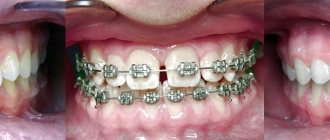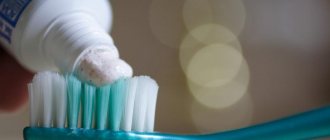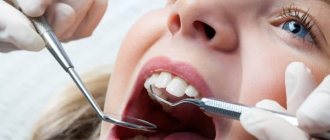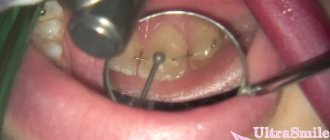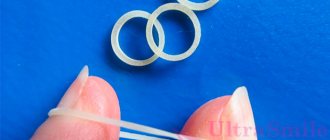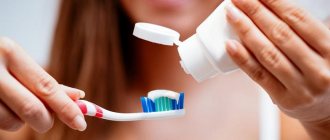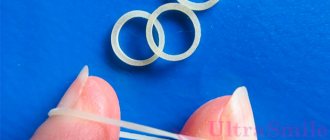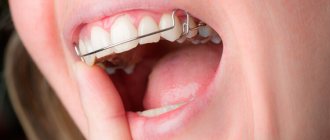- Getting used to braces
- Nutrition while wearing braces
- Rubber bands for braces
- Braces care
- How to properly glue wax to braces
We often encounter questions from customers who have installed braces and are faced with discomfort, pain and care problems - “how to avoid chafing and damage to the mucous membrane?”, “how to stop bleeding?”, “how to clean braces if regular brushes don’t work?”.
The first thing you should do after installing braces is to get your orthodontist's personal number. During treatment, especially during the period of adaptation, he is your main assistant. New sensations will cause anxiety, and you will call him with any question. The first time after installation, braces will rub the mucous membranes of the inner surfaces of the lips and cheeks, causing pain and inflammation.
Cleaning before braces: why is it needed?
Correction of the bite always begins with sanitation of the oral cavity. In addition to treating diseases of the teeth and gums, it includes mandatory professional cleaning before installing braces. The doctor will remove hard deposits with ultrasound, and soft deposits with a thin and powerful jet of cleaning powder solution (AirFlow technology). After this, the teeth will need to be polished with a special paste and coated with a fluoride-containing preparation to strengthen the enamel. Such a hygienic procedure should be carried out 3 - 5 days before installation, but no later than 24 hours.
What happens if you don’t brush your teeth before braces? Bacterial plaque will get under the elements of the system, in particular under the clasps that are glued to the enamel. Considering that orthodontic appliances are worn for a year at best, and two years on average, microorganisms will have enough time to multiply and lead to the formation of caries. It is impossible to properly cure it with braces on the teeth. There is a risk of early removal of the device, and this will spoil the final result, and the patient will waste money, time and moral strength. This is why brushing your teeth before getting braces is mandatory.
Don't forget to drink water
Pure water quenches thirst well, refreshes the oral cavity and does not contribute to the appearance of plaque, unlike tea and coffee. If the mucous membrane of the lips is sufficiently moisturized, it is not susceptible to drying out (especially in winter, when indoor air is dry), which means there is less risk that the orthodontic system will cause irritation.
All these rules are simple, and you get used to them within the first few days after starting treatment. Once adapted, they are easy to follow and do not interfere with your active life. In addition, the habit of brushing your teeth thoroughly remains, as a rule, for life, which also contributes to maintaining health.
More articles:
- Back to the orthodontist? All about re-treatment
- What hurts more: braces or aligners?
Rules for caring for braces after installation
And finally, the orthodontic structure is put on. There are many months, or even years of treatment ahead, during which you will need to devote a lot of time to oral hygiene. Cleaning braces is not an easy task. An orthodontic apparatus is a complex system with many elements: clasps, arches, ligatures, rings, springs, hooks for elastic rods... And on each of them food particles can remain and plaque can accumulate.
Recommendations for caring for the braces system
- You need to brush your teeth at least three times a day, and ideally after every meal, even a small snack.
- It is necessary to brush not only your teeth, but also between them. Dental floss will help clean the interdental space.
- The hygiene of braces must be the most thorough: all elements of the system will have to be processed on each side, avoiding the accumulation of plaque.
- You will have to purchase special brushes for cleaning braces, as well as additional devices such as an irrigator. We will talk about this in more detail below.
- To clean the braces system and teeth, a fluoride-containing paste is used, as well as a fluoride-containing rinse, which completes the oral hygiene procedure with braces.
- It’s best to always carry a toothbrush and floss with you in case you need to eat out.
- For those who wear braces, care and nutrition go hand in hand. During treatment, you will have to give up a number of foods—hard, sticky, fibrous, and anything else that could damage your braces or get stuck in them. You should also significantly limit sweets.
Hygiene of the brace system is a key task for the entire period of wearing an orthodontic device. If it is neglected, whitish spots may appear on the enamel of the teeth - traces of demineralization and the accumulation of bacterial plaque. They look unaesthetic and spoil the impression of the results of long-term treatment.
NUTRITION FEATURES
To avoid incidents while wearing an orthodontic device, you need to follow only 5 rules:
- You should avoid stringy and sticky foods. This group of products includes all chewing candies, toffees, chewing gums, nougat, and caramel. Any products that may become stuck in the system may move or change direction.
- Don't bite hard foods. Solid and tough foods can also change the tension of the arcs of the system. The therapeutic load can be damaged by nuts, hard apples, carrots, crackers, and sweets.
- Control the temperature of food. A sudden change of products can damage the enamel. Do not eat foods that are too hot or cold. The enamel can become too sensitive if cracks appear in it. Parts of the brace system can also be affected by temperature. Heat-sensitive parts react especially actively to changes in temperature. Such materials may lose their properties, stretch, or, conversely, narrow.
- Choose products without dyes. If the bracket system is ceramic, then this rule is very important. You should not consume beets, berries, sweet carbonated waters, tea, coffee, jam, ice cream with dyes, etc.
- It's better to give up alcohol. Alcohol dries out the mucous membrane, so this can provoke the development of bacteria. Liquor, alcoholic cocktails, wines - all this additionally stains the surface of the enamel and the system itself.
Solid foods can be crushed, but still, it is better to hold off with nuts, caramel and alcohol.
Hygiene products for braces
When a person wears braces, oral care consists of several stages. Each of them has its own tool, so the patient will have to acquire a whole arsenal of hygiene products.
Brush for cleaning teeth with braces
The orthobrush has a V-shape with a depression in the center of the pile, which is necessary for treating the surfaces of teeth and most of the orthodontic apparatus. This is where teeth cleaning with braces at home begins. Orthodontists also recommend purchasing a single-tuft toothbrush for cleaning braces. It will be useful for processing distant teeth and the outer part of locks.
Brushes for cleaning braces
It is also necessary to use brushes to clean braces. With their help, it is easy to clean the dental surface under the arcs of the device.
Superfloss
For oral hygiene with braces and cleaning the space between the teeth and around the clasps, you will need a special thread with a hard end - superfloss.
Oral irrigator
Separately, it is necessary to mention the most important device for cleaning braces - the irrigator. The device is somewhat similar to an electric toothbrush, but instead of bristles it has a nozzle from which a powerful stream of water is supplied. The irrigator helps clear plaque from hard-to-reach places where brushes and brushes cannot reach (for example, gum pockets).
Strengthening toothpaste
Wearing braces significantly increases the risk of caries. Therefore, it is worth thinking about prevention. Toothpastes with fluoride, hydroxyapatite crystals, theobromine and other strengthening substances will make your teeth stronger.
Classification of dental floss [4]
Due to their effectiveness, dental floss, or floss, has become widespread. Their entire range can be divided into categories according to several criteria.
According to the material:
- natural silk;
- rayon;
- nylon.
Nylon thread is becoming increasingly popular because it is stronger and cheaper than other options.
By surface type:
- waxed;
- unwaxed.
When choosing dental floss for braces, you should give preference to waxed floss. They glide better and are less likely to cling to orthodontic structures. When using unwaxed threads in wire braces, fiber fragments can get stuck and accumulate.
By design:
- regular thread;
- flat tape;
- superfloss.
To properly floss your teeth and braces, you need to have several varieties in your arsenal.
As a rule, dental floss is impregnated with substances that enhance anti-caries, antibacterial or other effectiveness: menthol, propolis, fluoride , chlorhexidine.
Why do you need to have your braces cleaned at the dentist?
No matter how thoroughly you clean your braces at home, it is impossible to 100% remove plaque accumulated in hard-to-reach places. This is why patients undergoing orthodontic treatment are recommended to have their braces professionally cleaned at least once every 6 months, and ideally once every quarter. It needs to be scheduled in the same way as regular visits to the orthodontist to monitor and correct the system.
Professional cleaning of teeth with braces is carried out according to the same scheme as in all other cases, but requires greater care from the doctor. Using the AirFlow device, the hygienist removes plaque, paying special attention to the areas around the locks. If necessary, ultrasound is also used to remove hard deposits in the pregingival zone (ultrasound cannot be used around elements of the orthodontic apparatus). After completing the procedure, it is worth carrying out surface fluoridation of the teeth to strengthen the enamel.
Professional hygiene will help avoid the appearance of whitish spots on the surface of the teeth. Therefore, to the question “Is it possible to do cleaning with braces?” we answer: “Not only is it possible, but it is also necessary!”
Rinse aid
Most rinses are used to eliminate unpleasant odors. It is important to understand: with high-quality cleaning of teeth with brushes, removing plaque and food debris, there should be no smell!
If you are sure that you are brushing your teeth correctly, and your dentist has confirmed that there is no plaque or inflammation of the gums, but the smell remains, you need to consult an ENT specialist and a gastroenterologist, because The cause of the smell may be hidden in diseases of the ear, throat, nose and gastrointestinal tract.
If you do decide to use a mouthwash, make sure that it does not contain chlorhexidine (this substance can give teeth a gray tint) and alcohol (it can irritate and dry out the mucous membranes).
Brushing your teeth after removing braces
You need to be attentive to oral hygiene not only during orthodontic treatment, but also after its completion. Care after removing braces plays an important role in preventing caries. The fact is that during the process of correcting the bite, the enamel is subjected to constant pressure. Dental care after braces often includes the use of special gels, pastes and varnishes that restore enamel density and reduce sensitivity.
Professional cleaning after braces will also not be superfluous. The hygienist will remove plaque and pigment inclusions and make an application that strengthens the enamel. If there are no contraindications, after removal of the system, patients can have their teeth whitened to return them to their original snow-white shade.
Brushing your teeth after braces at home should remain just as thorough. Of course, there will no longer be a need for a whole arsenal of brushes and brushes, but brushing your teeth twice a day and using floss is a must.
How to eat
There is no need to follow any diet while wearing braces. To maintain the original state of the system, especially if ceramic or sapphire plates are installed, only minor restrictions must be observed.
Dentists recommend avoiding the intake of hard, hot, cold, “sticky” foods, and also limiting the consumption of any products containing not only artificial, but also natural dyes. If the system is ceramic, it tends to easily absorb the coloring pigment. Avoid such bad habits. Smoking contributes to the deposition of plaque and darkening of the enamel/plates, and the habit of gnawing on something can lead to damage to the structure.
Taking care of braces and teeth is not difficult. You should be aware that neglect can lead to the development of caries or damage to the system, which will require additional material costs.

